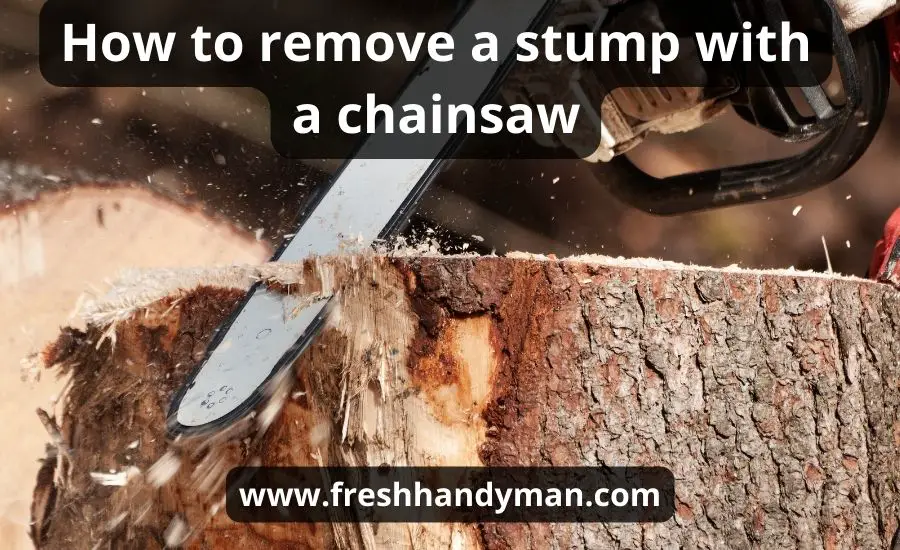Table of Contents
How to remove a stump with a chainsaw? Tree stumps can be a persistent eyesore in your yard, hindering your landscaping efforts and posing potential hazards.
Whether you’re dealing with small tree stumps, thick tree stumps, or big tree stumps, removing tree stumps is a task that requires proper techniques and tools.
In this comprehensive guide, we will explore the process of removing tree stumps using a chainsaw, covering everything from preparation and safety precautions to the actual removal of tree stumps and post-removal care.
Read on to learn how to effectively eliminate tree stumps from your property and achieve a smooth, stump-free ground level.
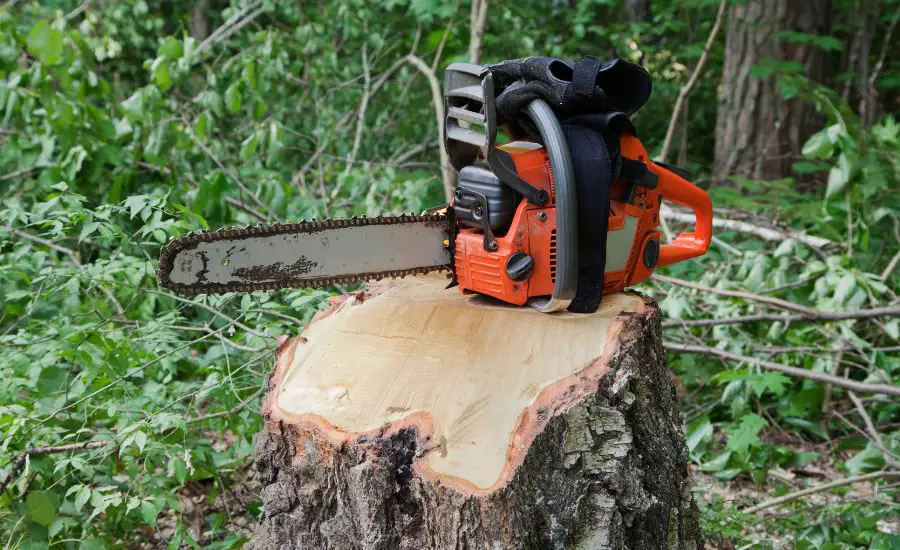
Preparation and safety gear
Before you begin the process of removing tree stumps with a chainsaw, it’s crucial to make thorough preparations and prioritize your safety.
In this chapter, we will discuss the necessary steps and protective clothing you should have in place to ensure the safe and effective removal of the tree trunk process.
Wear protective gear
Safety should always be the top priority when dealing with chainsaws and removing tree stumps.
To ensure your safety, make sure to wear the following protective equipment:
Safety glasses
These protective glasses shield your eyes from all the dirt (flying debris and wood chips), reducing the risk of eye injuries during cutting.
Hearing protection
The high noise levels generated by chainsaws can lead to hearing damage over time. Use earmuffs or earplugs to protect your hearing.
Helmet
A helmet with a visor or face shield provides essential head protection. It shields your face from all the dirt (wood particles and falling debris), ensuring you remain safe while working.
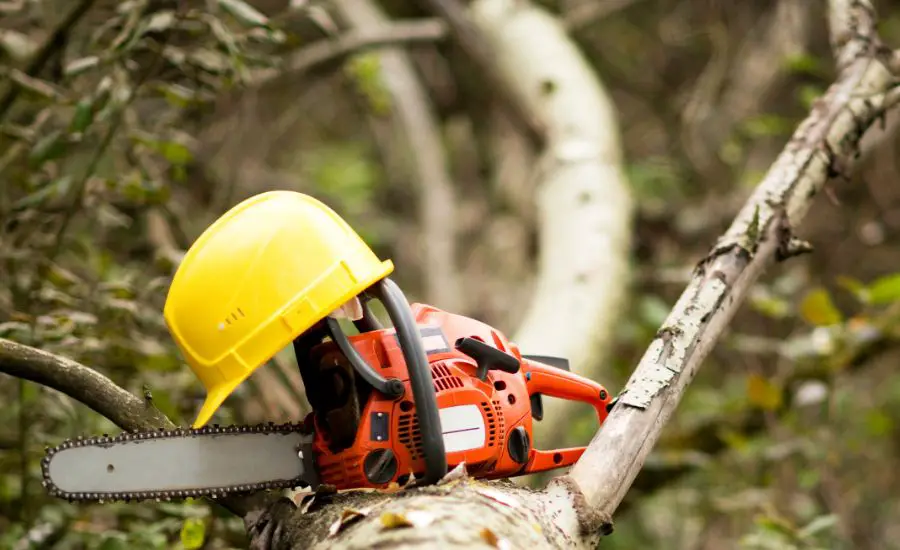
Chainsaw chaps or pants
These specialized pants or chaps are designed to protect your legs from accidental cuts by chainsaw blades. They have layers of cut-resistant fabric that can prevent severe injuries.
Steel-toed boots
Protect your feet from falling objects and potential chainsaw-related accidents by wearing sturdy steel-toed boots.
Gloves
Wearing gloves is crucial to maintaining a secure grip on your chainsaw and protecting your hands from splinters and cuts.
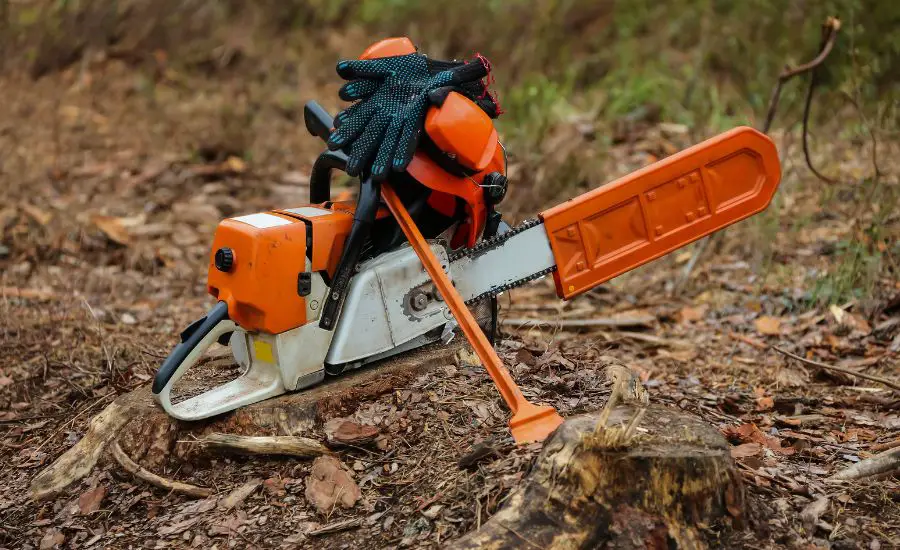
Chainsaw maintenance
Before starting the tree stump removal process, ensure that your chainsaw is in optimal working condition. Regular chainsaw maintenance includes:
- Checking the chainsaw blade for sharpness and ensuring it’s properly tensioned.
- Inspecting the fuel and oil levels to guarantee a continuous and safe operation.
- Lubricating the chainsaw chain to reduce friction and extend its lifespan.
- Cleaning the air filter to ensure efficient engine performance.
- Verifying that all safety features, such as chain brakes and throttle controls, are functioning correctly.
Proper chainsaw maintenance not only makes the job easier but also significantly enhances safety during the removal of the tree stump process.
Assessing the tree stump
Understanding the size, condition, and root system of the tree stump is crucial for planning an effective removal strategy.
In this chapter, we will discuss how to assess the tree stump and its surroundings comprehensively.
Size matters: small vs. large stumps
Tree stumps come in a wide range of sizes, from small and manageable ones to giant stump types, and stubborn stump behemoths. The removal process may vary depending on the stump’s size and thickness.
Smaller tree stumps are generally easier to remove with a chainsaw, while larger and thicker stumps may necessitate more advanced techniques, such as using a chainsaw grinder.
For smaller stumps, you can often rely on your chainsaw to cut through them effectively.
However, when dealing with larger or more substantial tree stumps, a chainsaw tree stump grinder or specialized equipment may be required to expedite the process.
Examining the root system
The root system of a tree stump plays a significant role in the removal process.
By examining the stump’s roots, you can determine whether they are close to the surface or deep within the ground.
This information will help you plan your cutting stumps strategy more effectively.
If the tree stump roots are primarily near the surface, it may be easier to cut and remove stumps with a chainsaw.
Deeper roots, on the other hand, may require more effort and specialized equipment to access and remove.
Assessing surroundings
Before you start cutting the tree stump, carefully consider the surroundings of the tree stump.
Are there any obstacles, structures, or other plants nearby that could impede your progress or pose safety risks?
Clear the area of any potential obstructions to ensure a safe and efficient removal process.
Taking the time to assess the stump’s size, root system, and the environment in which it is located will help you choose the most appropriate removal technique and ensure a successful outcome.
Cutting techniques for tree stump removal
In this chapter, we will delve into the various cutting techniques used for the removal of tree stumps with a chainsaw.
We’ll explore how to cut tree stumps, all the roots, and exposed roots effectively.
Tree stump cutting
To begin removing a tree stump with a chainsaw, follow these steps:
Horizontal cuts: start by making horizontal cuts near the top of the tree stump, gradually working your way down.
Ensure that these cuts create a flat and level surface on top of the stump.
Incremental cutting: as you cut deeper into the tree stump, make sure to proceed incrementally. Avoid forcing the chainsaw blade through the stump too quickly, as this can lead to blade binding or kickback.
Notch creation: once you’ve cut a significant portion of the tree stump, consider creating a notch on one side of the stump. This notch will serve as a guide to control the direction in which the stump will fall.
Cut to ground level: continue cutting until you’ve reached the level of the ground or as close as possible.
This ensures that the remaining tree stump is flush with the surrounding ground.
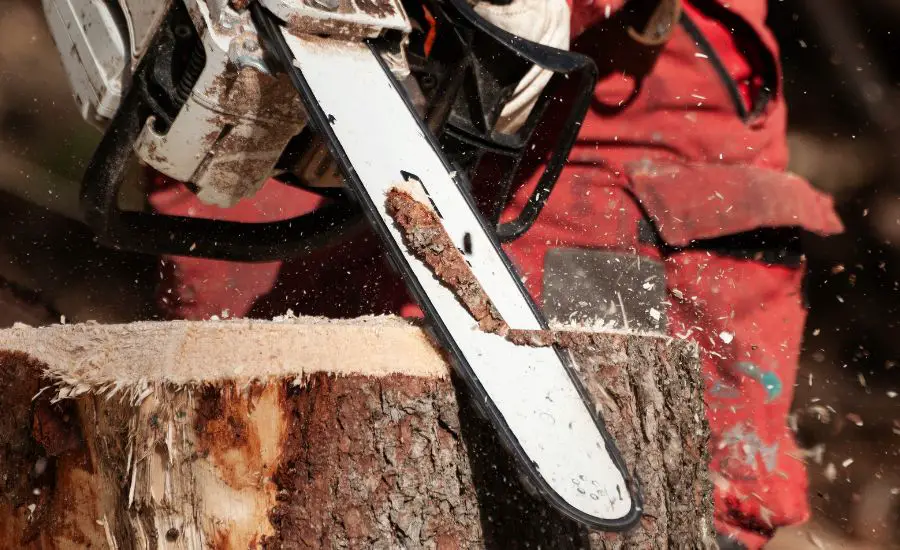
Cutting tree roots
When dealing with tree roots that extend from the tree stump, use the chainsaw to carefully sever them.
Follow these steps for cutting roots:
- Identify the roots: identify the roots that are visible above the ground.
- Precision cuts: make clean and precise cuts to sever these roots, ensuring that no stubs are left behind.
- Depth consideration: take into account the depth of the roots; some may be shallow while others may extend deeper into the soil.
- Safety first: exercise caution when cutting roots, as they can sometimes be under tension and may snap back.
Exposed roots
In cases where the tree stump has exposed roots, extra care is needed when cutting them. Here’s a more detailed approach:
- Clear debris: remove any soil or debris from around the exposed tree stump roots to ensure clear visibility.
- Examine the roots: inspect the roots for any splits, decay, or damage that may affect the cutting process.
- Precise cuts: use the chainsaw to make precise cuts along the exposed roots, taking care to avoid damaging the surrounding soil and grass.
- Gradual progress: work gradually, cutting small sections at a time, and reassessing as needed to avoid unexpected obstacles or difficulties.
Mastering these cutting techniques is essential for successful stump removal.
Patience and precision are key to ensuring a clean and effective cut.
Using a chainsaw stump grinder
For removing thick tree stumps and more stubborn ones, a chainsaw grinder may be necessary.
In this chapter, we will discuss how to use this specialized tool for the effective removal of stumps.
What is a chainsaw grinder?
A chainsaw grinder is a powerful attachment designed to work in tandem with your chainsaw. It features rotating blades or teeth that grind away the stump’s wood and root material, making it easier to remove tree stumps.
This tool is especially effective for large or challenging tree stumps.
Using a chainsaw grinder
To use a chainsaw grinder effectively, follow these detailed steps:
- Proper attachment: ensure that you correctly attach the stump grinder to your chainsaw as per the manufacturer’s instructions.
- Positioning: position the grinder blade over the center of the stump, ensuring that it is level and balanced.
- Gradual grinding: slowly lower the grinder blade into the stump while applying gentle pressure. Begin the grinding process, and move the grinder side to side to evenly grind away the stump material.
- Depth control: control the depth of grinding to reach the level of the ground or as desired. Take your time and make multiple passes if necessary to achieve the desired result.
- Safety precautions: during the grinding process, maintain a firm grip on the chainsaw, and be cautious of any kickback or unexpected movements. Always wear the appropriate protective clothing.
Using a chainsaw grinder can significantly speed up the stump removal process, especially for thicker or more challenging tree stumps. This tool is an efficient addition to your stump removal toolkit.
Removing stumps and roots
Now that you’ve successfully cut the tree stump and its roots, it’s time to remove stumps from the ground altogether.
This chapter will guide you through the final steps of stump removal.
Removing the stump
To remove tree stumps, follow these detailed steps:
- Excavation: begin by using a shovel or a pickaxe to carefully dig around the base of the stump. Create a trench to expose the stump’s root system.
- Root inspection: inspect the exposed tree stump roots and their connections to the stump. Identify any remaining roots that may still be firmly attached to the stump.
- Leveraging the stump: once you’ve adequately excavated and loosened the stump, use suitable tools like pry bars or a stump puller to leverage and lift it out of the ground. Depending on the stump’s size and weight, this may require additional assistance or mechanical aids.
- Disposal: dispose of the removed stump properly by recycling it, repurposing it as firewood, or contacting local authorities for disposal options. Avoid leaving it in your yard, as it can hinder future landscaping efforts.
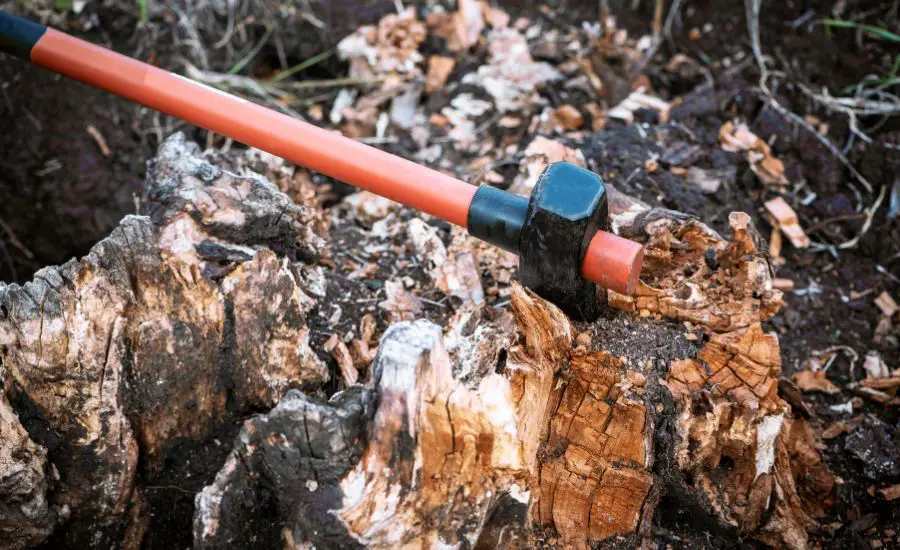
Clearing the remaining roots
After removing the main stump, take the time to inspect the area and ensure that all remaining roots connected to the stump have been removed. Any overlooked roots can lead to new growth or obstacles in your yard.
In some cases, it may be necessary to dig deeper or use specialized equipment to extract deeply embedded roots. Carefully examine the surrounding soil to ensure that no hidden root remnants remain.
Post-stump removal care
After removing the tree stump, it’s essential to take care of the remaining soil and ground.
This chapter will cover how to ensure that your yard remains healthy and stump-free.
Filling the hole
Once the stump and roots are removed, you will be left with a hole in the ground. To prevent settling and create a level surface, follow these steps:
- Backfilling: fill the hole with clean, fertile soil or topsoil, ensuring it is of the same composition as the surrounding soil.
- Tamping down: use a tamper or a piece of heavy equipment to firmly pack the soil down. This helps prevent uneven settling and ensures that the ground remains level.
- Regrading: if necessary, regrade the area to match the surrounding terrain and eliminate any noticeable depressions.
Grass seed and soil moisture
To restore the area to its natural beauty and encourage grass growth, consider these additional steps:
- Grass seed: spread grass seeds evenly over the filled area, following the recommended seeding rate for your specific grass type and climate.
- Watering: maintain consistent soil moisture by regularly watering the seeded area. Adequate moisture is crucial for germination and grass establishment.
- Mulching: applying a thin layer of mulch can help retain moisture and protect the newly seeded area from erosion.
By following these post-stump removal care steps, you can ensure that your yard recovers smoothly and maintains a healthy appearance.
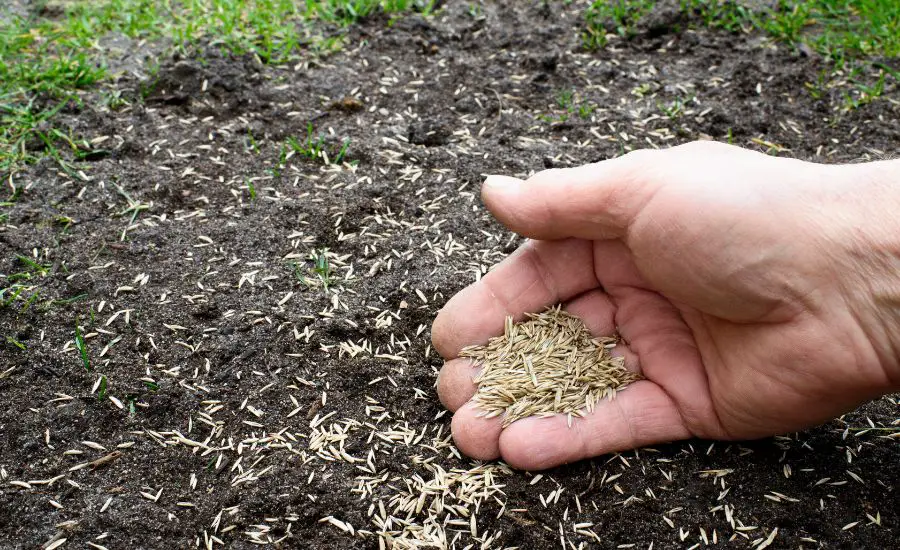
FAQ
Here are presented some of the most commonly asked questions on the topic of this paper with the following comprehensive answers to them.
Can I use chainsaw to remove stump?
Using a chainsaw to remove a tree stump is indeed a viable method, especially for smaller to medium-sized stumps. Chainsaws are versatile tools that can efficiently cut through wood, making them suitable for removal of stumps.
However, it’s essential to understand the limitations and considerations when using a chainsaw for this purpose.
For example, for thicker tree stumps, you may need to use a chainsaw grinder attachment or opt for alternative methods.
What is the fastest easiest way to remove a tree stump?
The choice of the best tool to remove tree stumps depends on several factors, including the stump’s size, thickness, and your level of expertise. Here are some tools commonly used for elimination stumps, along with their advantages:
1. Chainsaw. Chainsaws are versatile and can be used for removing stumps, especially smaller to medium-sized ones. They offer precision and control in making horizontal cuts, gradually reducing the stump’s size.
2. Chainsaw grinder. For larger or more challenging stumps, a chainsaw grinder attachment can be highly effective. It features rotating blades or teeth that grind away the stump material, making removal easier.
3. Ax or splitting maul. These hand tools are suitable for splitting and cutting through smaller stumps and roots. They require a physical effort but are accessible for most DIY enthusiasts.
4. Mattock. Mattocks are dual-purpose tools with a pick on one end and an adze on the other. They are handy for digging around the stump and cutting roots.
5. Stump grinder machine. For large or stubborn stumps, dedicated stump grinders are often the best choice. They can quickly grind stumps and roots below the level of the ground, making removal efficient.
Can you remove a tree stump without a grinder?
Yes, you can remove tree stumps without a grinder, but it may require more effort and time. Manual methods include using a chainsaw, digging around the stump, and leveraging the stump out with tools like a pickaxe or shovel.
Chemical stump removers are another option, although they take time to break down the stump.
What is the best tool for cutting tree stumps?
The best tool for tree stump cutting depends on the size and thickness of the stump. For smaller stumps, a chainsaw can be effective. For larger or more challenging tree stumps, a chainsaw with a stump grinder attachment or a dedicated stump grinder machine is recommended.
Each tool has its advantages and should be chosen based on the specific requirements of the job.
How do you remove a difficult stump?
Removing a difficult stump requires careful planning and the right tools. Here’s a general approach:
1. Start by using a chainsaw to make horizontal cuts near the top of the stump.
2. Gradually work your way down, cutting deeper with each pass.
3. Create a notch on one side of the stump to guide its fall direction.
4. For extremely difficult tree stumps, consider removing the stump with a chainsaw grinder or a dedicated stump grinder machine to grind the stump and its roots.
5. Once the stump is sufficiently cut or ground, use tools to lift and remove it from the ground.
6. Ensure that all remaining roots are removed, and fill the hole with soil, packing it down firmly.
Removing a difficult stump may require more time and effort, so be patient and take all necessary safety precautions during the process.
Conclusion
Removing a tree stump with a chainsaw can be a challenging but rewarding task. By following the steps outlined in this guide and using the appropriate techniques and protective clothing, you can successfully remove stumps of all sizes and types.
Remember to prioritize safety, assess the stump and its surroundings, and choose the right cutting technique for the job. Whether you’re dealing with small tree stumps or thick, stubborn giants, with the right tools and knowledge, you can achieve smooth, stump-free ground in your yard.
